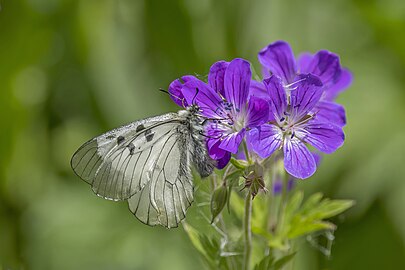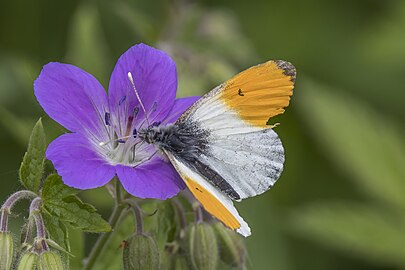| Geranium sylvaticum | |
|---|---|

| |
| Scientific classification | |
| Kingdom: | Plantae |
| Clade: | Tracheophytes |
| Clade: | Angiosperms |
| Clade: | Eudicots |
| Clade: | Rosids |
| Order: | Geraniales |
| Family: | Geraniaceae |
| Genus: | Geranium |
| Species: | G. sylvaticum |
| Binomial name | |
| Geranium sylvaticum L. | |
Geranium sylvaticum, the wood cranesbill or woodland geranium, is a species of hardy flowering plant in the family Geraniaceae, native to Europe and northern Turkey.
The Latin specific epithet sylvaticum means "of woodland", referring to the plant's native habitat, as does its common name "wood cranesbill".
Description
The plant grows to 75 cm (30 in) tall by 60 cm (24 in) wide, it is a mound-forming herbaceous, gynodioecious perennial with deeply cut and toothed 7-lobed basal leaves. In summer, flowers are borne on stalks with ruffs of leaves. The flower colour ranges from mauve to sky blue, depending on soil conditions. It has 10 stamens and glandular-hairy fruits.
Cultivation

G. sylvaticum is one of many Geranium species which are valued in gardens. It is suitable for cultivation in temperate climates in reliably moist, lightly shaded positions, as the name suggests. It is particularly useful for underplanting deciduous trees, roses, lilies, and other summer-flowering subjects. Various cultivars have been selected, of which 'Album' and 'Mayflower' have gained the Royal Horticultural Society's Award of Garden Merit.
Uses and traditions
It is the city flower of Sheffield in the United Kingdom.
The flowers yield a blue-gray dye that was used in ancient Europe to dye war cloaks, believing it would protect them in battle. For this reason it was called Odin's Grace.
References
- Elzinga, J.A., and Varga, S. 2017. Prolonged stigma and flower lifespan in females of the gynodioecious plant Geranium sylvaticum. Flora 226:72-81
- RHS A-Z encyclopedia of garden plants. United Kingdom: Dorling Kindersley. 2008. p. 1136. ISBN 978-1405332965.
- Marjorie Blamey and Richard Fitter, Collins Handguide to Wild Flowers of Britain and Northern Europe, William Collins Sons & Co. Ltd., London, 1979
- Webb, D.A. Parnell, J. and Doogue, D. 1996. An Irish Flora. Dundalgan Press Ltd, Dundalk ISBN 0-85221-131-7
- "RHS Plant Selector - Geranium sylvaticum 'Album'". Retrieved 13 July 2020.
- "RHS Plant Selector - Geranium sylvaticum 'Mayflower'". Retrieved 13 July 2020.
- "AGM Plants - Ornamental" (PDF). Royal Horticultural Society. July 2017. p. 42. Retrieved 1 March 2018.
- Plantlife website County Flowers page Archived 2015-04-30 at the Wayback Machine
- Hilderic Friend, Flower Lore, Para Research, Inc., Rockport, Massachusetts 1981.
| Taxon identifiers | |
|---|---|
| Geranium sylvaticum |
|
This Geraniaceae-related article is a stub. You can help Misplaced Pages by expanding it. |

